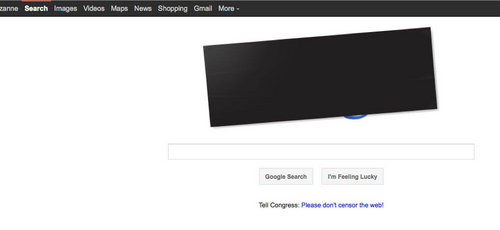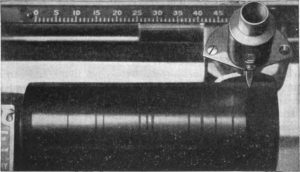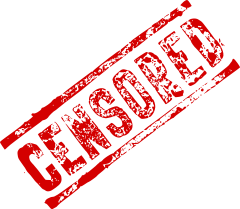The Internet Goes Dark in Protest
January 17, 2012
 Today, websites, companies, and individuals around the country are participating in the largest online protest in history as they battle two proposed bills currently pending before Congress, the Stop Online Piracy Act (SOPA) and the Preventing Real Online Threats to Economic Creativity and Theft of Intellectual Property Act (PROTECT IP Act or PIPA). Google, for example, has a black censorship box splashed over their logo today (pictured to the left), and Wikipedia has gone dark while providing information about how to contact you local representatives (if you just can’t live without Wikipedia today, the site is still available on mobile devices and smart phones, or by disabling JavaScript in your browser). A full list of the many popular websites protesting SOPA and PIPA today is here. We’ve written before about SOPA and PIPA, and about how they’ve come under fire by mainstream media and civil liberties groups who believe the bills would shift too much responsibility onto ISPs, advertisers, and payment processors while also giving the U.S. government and trademark and copyright holders too much power to block allegedly infringing websites without sufficient due process. Despite the powerful opposition to the bills, both are still alive as of today, January 18, 2012. Indeed, the Senate is set to vote on PIPA next week, and the House will resume their work on SOPA next month. See here for more information about the bills, the background, and the next steps. The bills have strong supporters as well. Chris Dodd, the chairman and CEO of the Motion Picture Association of America (MPAA), is one of these strong supporters and has stated that today’s online protest is “yet another gimmick, albeit a dangerous one, designed to punish elected and administration officials who are working diligently to protect American jobs from foreign criminals.” See here for Dodd’s full statement. Whether today's online protest serves to raise awareness and alter the language or course of these bills, or merely serves as a "gimmick" remains to be seen, although it is clear that thousands or perhaps millions of people who have never heard of either SOPA or PIPA will discover at least some of the many issues surrounding the bills as they go about their day today.
Today, websites, companies, and individuals around the country are participating in the largest online protest in history as they battle two proposed bills currently pending before Congress, the Stop Online Piracy Act (SOPA) and the Preventing Real Online Threats to Economic Creativity and Theft of Intellectual Property Act (PROTECT IP Act or PIPA). Google, for example, has a black censorship box splashed over their logo today (pictured to the left), and Wikipedia has gone dark while providing information about how to contact you local representatives (if you just can’t live without Wikipedia today, the site is still available on mobile devices and smart phones, or by disabling JavaScript in your browser). A full list of the many popular websites protesting SOPA and PIPA today is here. We’ve written before about SOPA and PIPA, and about how they’ve come under fire by mainstream media and civil liberties groups who believe the bills would shift too much responsibility onto ISPs, advertisers, and payment processors while also giving the U.S. government and trademark and copyright holders too much power to block allegedly infringing websites without sufficient due process. Despite the powerful opposition to the bills, both are still alive as of today, January 18, 2012. Indeed, the Senate is set to vote on PIPA next week, and the House will resume their work on SOPA next month. See here for more information about the bills, the background, and the next steps. The bills have strong supporters as well. Chris Dodd, the chairman and CEO of the Motion Picture Association of America (MPAA), is one of these strong supporters and has stated that today’s online protest is “yet another gimmick, albeit a dangerous one, designed to punish elected and administration officials who are working diligently to protect American jobs from foreign criminals.” See here for Dodd’s full statement. Whether today's online protest serves to raise awareness and alter the language or course of these bills, or merely serves as a "gimmick" remains to be seen, although it is clear that thousands or perhaps millions of people who have never heard of either SOPA or PIPA will discover at least some of the many issues surrounding the bills as they go about their day today.


 I’ve written before about common law copyright protection of sound recordings made before February 15, 1972. Although the Sound Recording Amendments to the 1909 Copyright Act extended federal copyright law to sound recordings, it only did so to sound recordings made on or after February 15, 1972. Per the amendments, federal copyright law does not preempt state common law or statues regarding pre-1972 sound recordings until February 15, 2067. This has resulted in a meshwork of state common law copyright protecting – or not protecting – pre-1972 sound recordings. In 2009, Congress instructed the Copyright Office to conduct a study on the “desirability and means” of extending federal copyright protection to pre-1972 sound recordings, and
I’ve written before about common law copyright protection of sound recordings made before February 15, 1972. Although the Sound Recording Amendments to the 1909 Copyright Act extended federal copyright law to sound recordings, it only did so to sound recordings made on or after February 15, 1972. Per the amendments, federal copyright law does not preempt state common law or statues regarding pre-1972 sound recordings until February 15, 2067. This has resulted in a meshwork of state common law copyright protecting – or not protecting – pre-1972 sound recordings. In 2009, Congress instructed the Copyright Office to conduct a study on the “desirability and means” of extending federal copyright protection to pre-1972 sound recordings, and  Two related bills aimed at curbing rampant copyright and trademark infringement on the Internet are currently pending before the House and Senate. While the bills have been endorsed by the RIAA and MPAA and have strong bipartisan support in Congress, they have come under fire by mainstream media and civil liberties groups who believe the bills would shift too much responsibility onto ISPs, advertisers, and payment processors while also giving the U.S. government and trademark and copyright holders too much power to block allegedly infringing websites without sufficient due process. The Senate PROTECT IP Act of 2011 (S.968) The bills began in the Senate, where Senator Patrick Leahy (D-VT) introduced the Preventing Real Online Threats to Economic Creativity and Theft of Intellectual Property Act,” or the PROTECT IP Act (“PIPA”) in May of 2011 (
Two related bills aimed at curbing rampant copyright and trademark infringement on the Internet are currently pending before the House and Senate. While the bills have been endorsed by the RIAA and MPAA and have strong bipartisan support in Congress, they have come under fire by mainstream media and civil liberties groups who believe the bills would shift too much responsibility onto ISPs, advertisers, and payment processors while also giving the U.S. government and trademark and copyright holders too much power to block allegedly infringing websites without sufficient due process. The Senate PROTECT IP Act of 2011 (S.968) The bills began in the Senate, where Senator Patrick Leahy (D-VT) introduced the Preventing Real Online Threats to Economic Creativity and Theft of Intellectual Property Act,” or the PROTECT IP Act (“PIPA”) in May of 2011 ( Upblog, my co-blogger Blaine linked a
Upblog, my co-blogger Blaine linked a  The
The